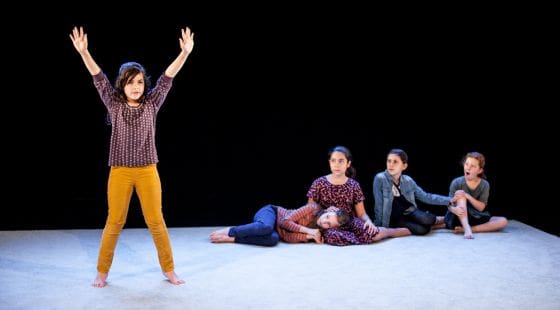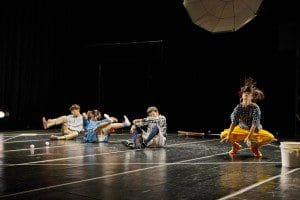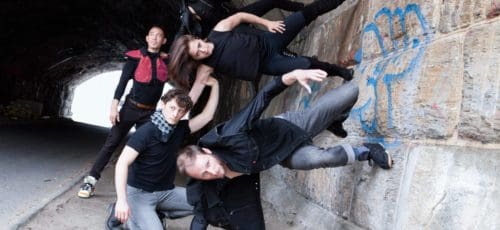Winter at FringeArts lights up the waterfront
Communications Intern Hugh Wilikofsky shares his comprehensive guide to the FringeArts Winter season.
As we gear up for our first show of 2016, we at FringeArts simply cannot contain our excitement over our entire upcoming winter season. Literally. It is tearing us all apart. We’ve been screaming about it at the top of our lungs for some time now and the neighbors hate us. This excitement needs an outlet. So, I am going to do my professional duty and alleviate at least a little bit of that need by clueing you all in to the future goings-on here by the waterfront.
First up, showing January 21-23 is Toshiki Okada’s latest play God Bless Baseball. A collaboration between Japanese and South Korean actors, the play follows two girls as they attempt to comprehend their countries’ favorite pastime with the help of a man who understands the game but despises it, and another who thinks he’s Japanese baseball star Ichiro Suzuki. However, despite the men’s best efforts, the girls continually frustrate their explanations, slowly teasing out just how deeply rooted the game is in the everyday life of Japanese and South Korean people.
Though most contemporary Japanese theater rarely makes it outside of the country (as far as I know, though I’d be happy to be wrong on that one), since 2009 Okada’s work has received regular productions here in the US. His oeuvre is said to represent Japan’s “lost generation,” the group most affected by the Japanese recession of the 1990s and this is perhaps part of why he has found an audience here, in the wake of our own Great Recession. Characterized by the idiosyncratic vernacular of Japanese twentysomethings, his vérité writing style is in some ways akin to that of renowned American playwright Annie Baker, but his use of disjointed and abstract choreography based on exaggerations of everyday gestures imbues his works with a quirk all his own. On top of the Philadelphia premiere of God Bless Baseball, FringeArts will also be hosting a reading of Okada’s The Sonic Life of a Giant Tortoise directed by Pig Iron Theater Company artistic director Dan Rothenberg on January 18.
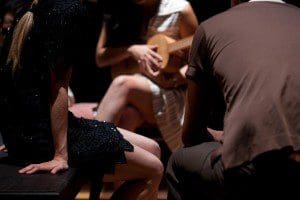
Photograph: Valentino Saldivar
Next up, showing January 28-30 is Chilean playwright/director Guillermo Calderón’s latest play Escuela. Set in Chile in the late 1980s, amid the tumultuous transition between the brutal dictatorship of Augusto Pinochet and the dubiously regarded democracy that followed, a group of left-wing university students receive secret paramilitary training in the living room of a fellow dissident. Hiding their identities with hoods to ensure none of them can betray their revolutionary comrades, these intellectuals awkwardly learn skills essential to guerilla warfare, such as proper crawling and rifle cleaning methods, in the hopes of overturning a corrupt regime, all while grappling with the chilling realities of staging a violent insurgency.Calderón has made a name for himself with plays grounded in times of violent turmoil and political upheaval, using dangerous and unstable settings as a jumping off point for larger universal themes, and Escuela sits well within this established style while taking it somewhere new. Instead of the surrounding violence haunting the onstage proceedings, as it did in Calderón’s first play Neva, it is brought to the forefront in Escuela as we watch its characters preparing to engage with it. In an interview with FringeArts, regarding the political implications of his new work Calderón asserted, “Politics is a combination of emotions and rationality, and that is what Escuela tries to convey and push to its limit.”
Kicking off February is a multimedia performance from composer Daniel Wohl, who previously graced the FringeArts stage last year with a multi media performance of his album Corps Exquis. This time around the Paris-born composer will be presenting his latest full-length album, Holographic, accompanied by an excellent line up of musicians and video art projections from LA-based artist Daniel Schwarz.
Wohl has garnered acclaim for works in which the acoustic and electronic blend into each other: a resonating snare drum becomes a low unnerving drone, percussion and electronic noise crash into a joyous cacophony, and synthetic pulsations elevate the steady bowing of strings to a higher plane. The result is immersive, slyly disorienting music that seeks to close the gap between the chamber groups of concert halls and academia , and electronic experimentalists pushing sonic boundaries in basements and warehouses. This is a one night only event, so mark your calendar for February 5.
Our first dance piece of the season, The Unofficial Guide to Audience 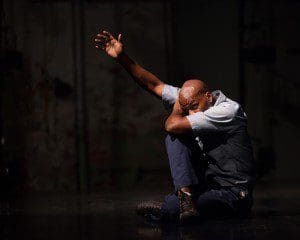 Watching Performance, comes from the wildly accomplished Philadelphia based artist Raphael Xavier, with performances February 11-13. A renowned breaker, Xavier plays a substitute teacher who, after a life of struggling as an artist, must begrudgingly take a teaching job. The audience become his students as he walks them through his life as practitioner of the hip hop dance aesthetic, showing them younger versions of himself at the height of his abilities displaying the remarkable endurance needed to survive in the dance battle world. He breaks down these movements—frozen, slowed down, in close-up—to give his audience a better understanding of the art form so central to his identity.
Watching Performance, comes from the wildly accomplished Philadelphia based artist Raphael Xavier, with performances February 11-13. A renowned breaker, Xavier plays a substitute teacher who, after a life of struggling as an artist, must begrudgingly take a teaching job. The audience become his students as he walks them through his life as practitioner of the hip hop dance aesthetic, showing them younger versions of himself at the height of his abilities displaying the remarkable endurance needed to survive in the dance battle world. He breaks down these movements—frozen, slowed down, in close-up—to give his audience a better understanding of the art form so central to his identity.
Though Xavier is best down for his accomplishments in the world of dance as an innovative movement conceptualist, he is also a rapper, producer, comedian, actor, photographer, and writer, and all the experience accrued from his lifetime as a multifaceted artist play into this work. “Bringing all my skill sets together to tell a 75% real life and 25% fictitious story actually equates to a 100% real life story from age thirteen to forty-five,” he told FringeArts, adding, “Each moment of my life and each moment I spend dancing on many stages around the world went into creating this work.” As a result, the audience is fortunate enough to bear witness to an artist reflecting on a lifetime of achievement, at the same time creating something new, wholly original, and deeply personal.

The weekend is capped off with a performance from Grammy-winning vocal ensemble Roomful of Teeth on February 14. Since 2009, this octet has met annually at the Massachusetts Museum of Contemporary Art to study an astonishingly wide range of vocal traditions and techniques from all over the world with masters of the forms. Tuvan throat singing, yodeling, belting, Inuit throat singing, Korean P’ansorr, Georgian Singing, Sardinian cantu a tenore, Hindustani music, Persian classical singing, and even more have a place in their unique, trans-global aural world where the music is unpredictable, adventurous, and more forward-thinking than anything you’ve heard associated with the term “a capella.”
The group has received widespread critical acclaim since the release of their self-titled debut in 2012, topping many critics’ year end best of lists and garnering a Grammy Award for Best Chamber Music/Small Ensemble performance in 2014 (c’mon Grammys, get with the times). Additionally, ensemble member Caroline Shaw received the Pulitzer Prize in Music for Partita for 8 Voices, the four movements of which appear on her group’s debut (she also recently collaborated with Kanye West if Pulitzer Prizes just don’t do it for you). The group’s sophomore album, Render, was released in April of last year and once again garnered widespread acclaim, being dubbed “both beautiful and groovy as hell” by The Thoroughfare. Now doesn’t that sound like something you want to experience on a lazy Sunday evening?
 Our last show in February comes from the Brooklyn-based theater company 600 HIGHWAYMEN and features a cast of incredibly talented young girls grappling with the story of a woman growing and transforming over a lifetime. Employee of the Year tells the story of J., whose house burns down, compelling her to leave everyone and everything she knows behind. Citing journey myths, the writing of Joseph Campbell, and Terrence Malick’s Days of Heaven as influences on the work, 600 HIGHWAYMEN directors Abigail Browde and Michael Silverstone claim, “We wanted to make a story about someone who is exposed to the elements of life; someone who gets hurt, who picks themselves up, and who goes on.” The remarkable play for adults, told by children, comes to FringeArts February 26-27.
Our last show in February comes from the Brooklyn-based theater company 600 HIGHWAYMEN and features a cast of incredibly talented young girls grappling with the story of a woman growing and transforming over a lifetime. Employee of the Year tells the story of J., whose house burns down, compelling her to leave everyone and everything she knows behind. Citing journey myths, the writing of Joseph Campbell, and Terrence Malick’s Days of Heaven as influences on the work, 600 HIGHWAYMEN directors Abigail Browde and Michael Silverstone claim, “We wanted to make a story about someone who is exposed to the elements of life; someone who gets hurt, who picks themselves up, and who goes on.” The remarkable play for adults, told by children, comes to FringeArts February 26-27.
March brings the remarkable performance piece Bronx Gothic, from  multidisciplinary artist Okwui Okpokwasili. Centered around a series of notes passed between two 11-year-old girls, the work probes the private world of the girls’ tumultuous relationship as they creep towards adolescence and sexual awakening in the 1980s outer-borough of New York City. Explaining her inspirations to FringeArts, Okpokwasili argued, “In the popular imagination urban dwelling, gum chewing, subway hopping, loud and independent young brown girls were not the symbol of innocence that I grew up with,” adding, “I wanted to make an argument for a brown girl innocence, charged and precocious and dreamy.”
multidisciplinary artist Okwui Okpokwasili. Centered around a series of notes passed between two 11-year-old girls, the work probes the private world of the girls’ tumultuous relationship as they creep towards adolescence and sexual awakening in the 1980s outer-borough of New York City. Explaining her inspirations to FringeArts, Okpokwasili argued, “In the popular imagination urban dwelling, gum chewing, subway hopping, loud and independent young brown girls were not the symbol of innocence that I grew up with,” adding, “I wanted to make an argument for a brown girl innocence, charged and precocious and dreamy.”
Influenced by West African griot storytelling traditions and Victorian era novels, the text is crucial to the piece, but the movement is equally arresting, exhibiting the virtuosic talents that have made her a major name in the world of modern dance. Bronx Gothic, which garnered a 2014 Bessie Award for outstanding production, shows March 11-12.
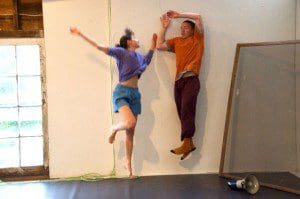 Our final performance of the winter season comes from previously FringeArts presented dancer Gabrielle Revlock and her collaborator Aleksandr Frolov. Show No Show charts the relationship of two people getting to know each other for the first time, all awkwardness, openness, and vulnerability—and not many boundaries. Unpredictable and entrancing, they use each other and the space to mine the complexities of opening oneself up to another, and all the hilarious, maddening, and heartbreaking feelings that come with it.
Our final performance of the winter season comes from previously FringeArts presented dancer Gabrielle Revlock and her collaborator Aleksandr Frolov. Show No Show charts the relationship of two people getting to know each other for the first time, all awkwardness, openness, and vulnerability—and not many boundaries. Unpredictable and entrancing, they use each other and the space to mine the complexities of opening oneself up to another, and all the hilarious, maddening, and heartbreaking feelings that come with it.
Revlock and Frolov met during a three-week residency at the Omi International Arts Center in August of 2014 and began developing this new work, however, the connection between the two was not immediate. Revlock recalled of their first partnership for an exercise at the residency, “It was super awkward and did not go well and so I thought, ‘Okay, tried that, didn’t work, no chemistry, moving on.’” Thankfully they had another chance to work together before long and found the previously absent chemistry they needed to keep experimenting. Now we, as the audience, can reap the rewards of their partnership March 24-26.
What an incredible season! We’ll be at every one – see you there?
— Hugh Wilikofsky
Buy tickets or get more information at fringearts.com/shows. Remember you can see all of our Winter offerings, as well as every other year-round and Festival show, at 30% off with a membership, as well as reaping all the benefits that come with being a member of the FringeArts family.

